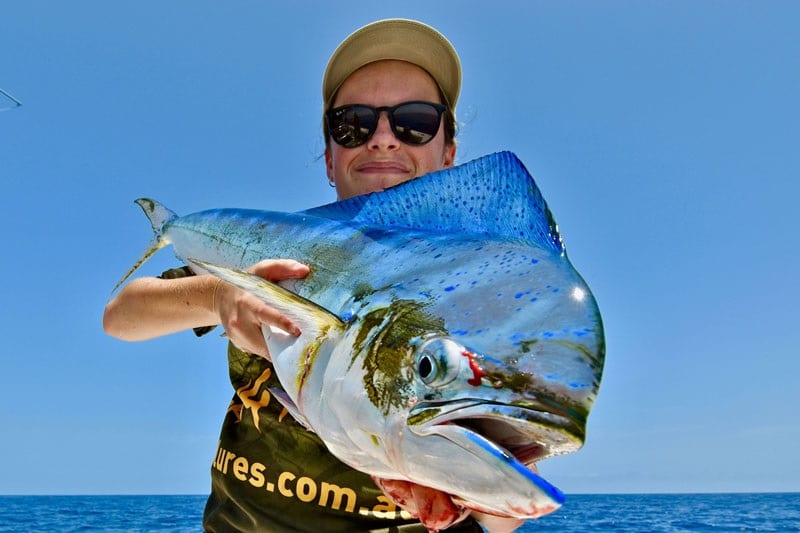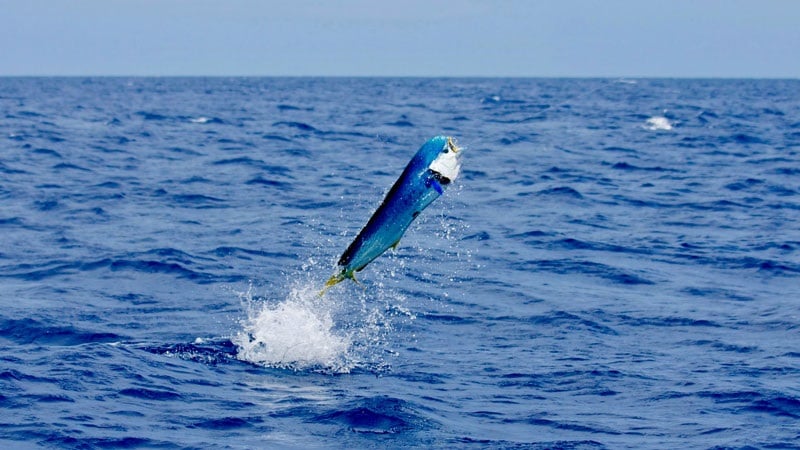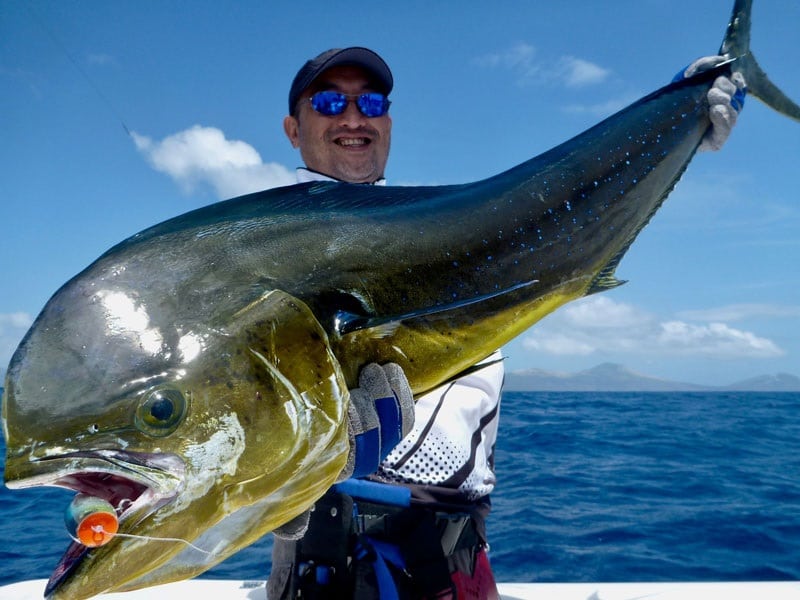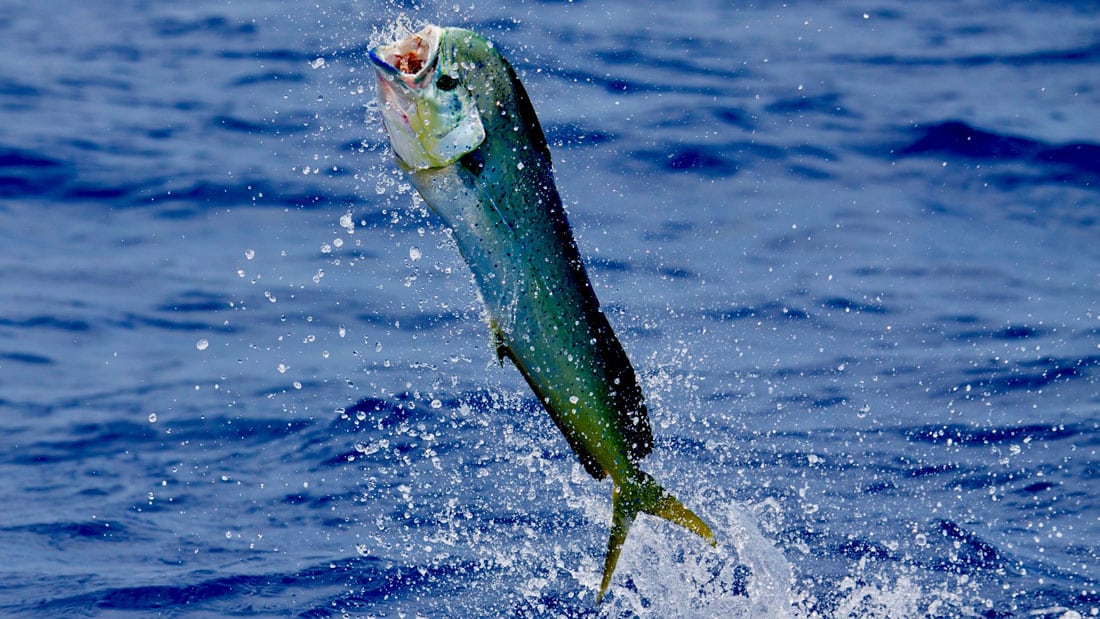Want to catch a fish that is abundant, puts up a great and acrobatic fight, aggressively hits artificial lures, attacks in schools and is delicious to eat? Then Mahi Mahi is the fish for you! They are a very popular gamefish worldwide but is often overlooked and is placed as a second stringer but in other parts of the world, they have developed their own specific niche industry having specific rods, reels, rigs and lures designed just for the purpose of catching them.
Here in Vanuatu, we encounter a lot of Mahi Mahi and our guests love to catch them. Readily available year-round, they are one of our favorite species to target both inshore and offshore. With decades of experience chasing these colorful predators under our belts, we have some useful tips to share with you for your next Mahi Mahi session.
About Mahi Mahi (Coryphaena hippurus)
Also known as Dolphinfish and Dorado, the Mahi Mahi is a highly migratory schooling fish found all around the world, particularly in tropical or sub-tropical blue-water open ocean. They can be fished in between the depths of 37 to 85 meters. Their specie is typically short-lived that they only have a life span of four to five years and are among the fastest growing fish in the world, with population doubling in just 15 months. However, they are also one of the most vulnerable fish out there.
Their diet consists of crabs, crustaceans, squid, small fish and sargassum weed among other sea creatures and plants. Young Mahi Mahi tends to travel in groups of up to 50 or more fish – this is their natural defense from attacks. As they get older their group will become smaller and smaller until they will just swim around with a single buddy.
They are abundant, aggressive, gives an acrobatic fight and a great eating fish.
Frequent Locales
Mahi Mahi are structure-oriented fish and will lurk around and under large mats of floating weeds, FADs and other large floating debris like logs and the odd barrel. If you find some sort of floating structure offshore with bait around, you’ll most likely find them there and it is worth it to troll around said structure or even cast some lures around the area.
Right Fishing Gear
Mahi Mahi comes in all sizes and almost all feed in schools and the bigger specimens come in pairs so be prepared for some chaos when you find them. We’ll catch them on all sorts of outfits, from trolling gear to even fly tackle and it is quite hard to specify one single outfit for targeting them as their size vary but if we were to choose a favorite setup, it would be a PE4 spinning outfit as this would cover most bases, from light trolling, pitching baits and casting lures. Trolling outfits for sailfish and wahoo are also a popular outfit that work well when targeting Mahi Mahi, from a size 16 overhead reel to a size 20, spooled with 8kg test monofilament is great fun. Modern techniques and gear built with braided line in mind are top choices but most of the gear that you already have for saltwater inshore and offshore work will be fine.
Troll and Switch
This technique is commonly used around the world and can be the most effective way to catch Mahi Mahi in numbers. First, we find the weeds that hold bait and life then slow troll the area to around 6 – 7 knots and put out a spread of blunt headed skirts rigged with strip baits. Limiting the spread to 4 lines on smaller boats and 6 lines on bigger boats. More lines in the water generates more chances of tangles so try to be minimalistic yet effective. Mahi Mahi attacks in schools and will fight over one bait until one is hooked up. Once hooked up, keep the boat moving as the school will find the other baits in the spread and keep the action hot. Let an angler fight the hooked fish while continuing the troll as multiple hookups are very common in this scenario. Once you see the school latched onto the action behind the boat, get your spinning outfits rigged with pitch baits rigged on bucktail jigs ready and cast them out to the school. Keep baits in the water while the action is hot so the fish won’t lose interest. When you get on to bite a pitched bait, allow the fish to swallow the bait in free spool for about 5 seconds before closing the bail and setting the hook. Eventually the bite tapers off and you’ll have to troll around the weeds again. Rinse and repeat.
Topwater Poppers and Stickbaits + Pitch Bait Switcheroo
There will be times when the fish just go berserk and will readily inhale topwater lures with gusto. Times like these are when you bring out your PE3 – 4 popping outfits and cast away. Mahi Mahi’s favorite food is the flying fish so work lures fast and create as much surface commotion to generate an impulse strike. You’ll see the school fight for the lure so don’t get overexcited and pull the lure away from them. Wait for a solid hit and allow the fish to take line on medium drag before giving your rod a smooth and solid pull to set the hooks right. Like tip #1 above, keep casting to keep the action going until the bite tapers off.
Another technique is to tease them with a popper then switching to a pitch bait once on the surface. A popper will trigger a Mahi Mahi’s feeding instinct and cause a chain reaction making the school hunt for food. Work a popper aggressively and get as much topwater commotion as you can. The popping sound permeates through the water and the sight of a “fleeing baitfish” will trigger their aggressive nature. Once the fish rise to the popper, pitch out your baits and get ready for a hookup.If you want to experience reeling in the awesome Mahi Mahi, BOOK NOW a Vanuatu fishing adventure with Ocean Blue Fishing!
Call us now at 1300 564 616 or at (INTL) +61 436 020322 or you may also contact us through our website at https://www.oceanbluefishing.com/enquire





[…] We have maxed out our extra large fish bags a couple of times now and we can confidently share that it can hold 2x 60kg tuna, with some more space for a couple of Wahoo and Mahi-Mahi. […]
[…] We have maxed out our extra large fish bags a couple of times now and we can confidently share that it can hold 2x 60kg tuna, with some more space for a couple of Wahoo and Mahi-Mahi. […]
[…] We have maxed out our extra large fish bags a couple of times now and we can confidently share that it can hold 2x 60kg tuna, with some more space for a couple of Wahoo and Mahi-Mahi. […]